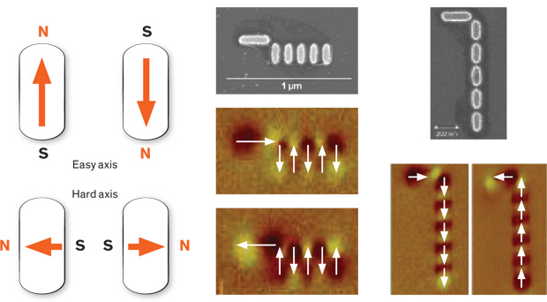Building Ultra-Energy-Efficient Computers Out of Tiny Bar Magnets
Nanomagnet computers could consume one-tenth power of today’s microprocessors
By Francis Pelletier | September 1, 2015 at 2:44 pmIEEE Spectrum has published an article written by Wolfgang Porod is a professor of electrical engineering, and Michael Niemier is a professor of computer science and engineering. Both are based at the University of Notre Dame, Indiana.
The magnetic field of an elliptical nanomagnet naturally prefers
to align along the longer, or ‘easy,’ axis [top illustrations, left].
Wires can be constructed in two ways. One is by arranging the magnets
side by side [center], where their magnetizations prefer to alternate
in direction. The other is end to end [right], where all magnetizations
prefer to point in the same direction. All arrows point north.
(Images: Edit Varga/University of Notre Dame)
Abstract: “When it comes to computing, we can very easily divide the technologies we use into two distinct categories: speedy electronics and stable magnetics. Electrons, which move fast and interact strongly with one another, are ideal for performing computation. Magnets, by contrast, aren’t known for their speed, but they’re hard to perturb, making them the perfect medium for data storage. But this division may soon disappear. Thanks to modern fabrication technology, we can now create nanometer-scale magnetic devices that can perform computations. These devices are not as speedy as state-of-the-art transistors, but they require far less energy to switch.. We’ll need devices like these because modern chips are consuming too much power. Today, the amount of electricity needed simply to maintain data in a circuit—called standby power—is fast approaching the amount that’s consumed when an actual computation is performed. Magnet-based devices, which require no power to save their state, could drastically cut down on this constant power drain, which is one of the main obstacles to continued progress in chips. ”















 Subscribe to our free daily newsletter
Subscribe to our free daily newsletter

